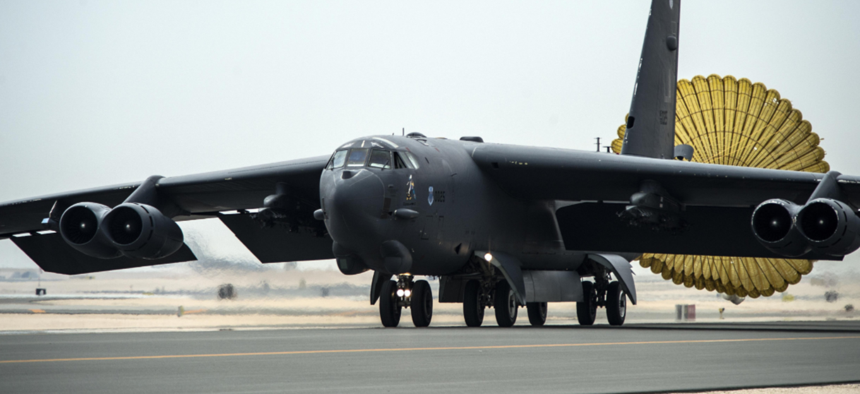
A U.S. Air Force B-52 Stratofortress arrives at Al Udeid Air Base, Qatar, April 9, 2016, for Operation Inherent Resolve. U.S. Air Force / Tech. Sgt. Nathan Lipscomb
It’s Long Past Time to Rethink US Military Posture in the Gulf
The rift between Qatar and other Gulf nations should prompt a long-overdue review of what the Pentagon keeps in the region, and where.
A number of U.S. officials, including President Trump and Rep. Ileana Ros-Lehtinen, R-Florida, have recently suggested that the U.S. military should consider eliminating its military presence in Qatar. Doing so precipitously would be a mistake, and given the strategic, operational, and financial stakes, rather unlikely. But there are other reasons to rethink U.S. military posture in the Middle East for the demands and limitations of the 21st century. Challenges with Iran, competition with Russia and China, counterterrorism imperatives, and domestic political and budgetary realities make a meaningful review long overdue.
The crisis between Doha and its Gulf partners, fueled by long-simmering tensions over regional competition, is unlikely to abate any time soon. Gulf disunity is unhelpful for several reasons, including impeding efforts to counter ISIS and Iran. U.S. Central Command has indicated that the political crisis is undermining its ability to conduct long-term planning. At a very practical level, the U.S. military may find its robust presence in Qatar narrowed, which would call into question the parameters of U.S. force posture across the Middle East.
This presence is centered on al Udeid air base, the U.S. military’s largest base in the region. Built in the 1990s with $1 billion from Qatar — and expanded and improved with $450 million in U.S. military construction funds since 2003 — al Udeid is home to nearly 10,000 U.S. military personnel and the longest runway in the Gulf. The base supports U.S. Central Command’s forward headquarters, the Combined Air and Space Operations Center with representatives from 20 or so nations, and the 379th Air Expeditionary Wing. Qatar also hosts Camp As Sayliyah, where the U.S. Army keeps enough armor for a brigade-sized force in the event of contingencies or crises.
Moving the forces at al Udeid to a new regional home or homes would be difficult for political, operational, and financial reasons. At the political level, limiting the base’s operations or moving it would disrupt relations with the Qataris on other regional security priorities and would send a strong signal to other regional allies. As well, in a political environment where the United States may be asking allies and partners to pay more for a strategic relationship, Qatar appears already to be paying its share.
Operationally, losing access at al Udeid would severely impede the command, control, and coordination of air operations against ISIS, as well as U.S. military assistance to Saudi Arabia and the UAE in the Yemen conflict. And at a purely financial level, finding the money to replace this infrastructure would require significant tradeoffs in an already crowded U.S. defense budget.
The benefits of the current distributed military posture are clear. At the political level, it lowers the U.S. dependency on any one country, since political tensions can affect military relationships—as the Qatar row illustrates. (Recall as well why U.S. military shifted its major base of operations to Qatar in the first place: domestic political concerns in Saudi Arabia had made it untenable for the Kingdom to continue hosting U.S. forces.) The U.S. military’s dispersal across at least seven countries in the Middle East and over 10 bases in Asia, for example, show countries like Iran and China that in a conflict, they are severely outnumbered by U.S. allies and partners, enhancing deterrence and reassurance. Disaggregated posture allows for operational resiliency, particularly in theaters where adversaries have plenty of missiles that could impede operations at any particular base.
Yet there are also costs to this posture. To date, even substantial U.S. domestic pressures have had a limited effect in forcing the U.S. military to reconsider its presence in a country. Bahrain is the latest example, where the government’s virulent crackdown on its Shi’a population prompted real concerns by some members of the State Department and Congress over both the optics of the U.S. base in Manama and the potential risks to it. Nevertheless, these concerns were overridden by security imperatives, maintaining the political relationship with Saudi Arabia (the dominant power in Bahrain), and operational priorities for counterterrorism and Iran deterrence missions.
To be sure, no U.S. base is irreplaceable, as the U.S. military found in 1992 when Subic Bay and Clark Air Field were closed, the latter by a volcano and the former by the Philippine government’s infighting. And at a minimum, paying for most of this posture out of Overseas Contingency Operating funds is problematic—indeed, the latest budget request estimates that it will cost about $30 billion annually to maintain forward presence and readiness in the broader Middle East. But it is also too easy for dependency on access to become inextricably tied to political expectations and commitments to allies and partners.
Beyond the current political crisis in the Gulf, it’s far past time to acknowledge that U.S. military posture in the Middle East requires a serious and meaningful review. Realistically, this is mostly likely through Congressional legislation requiring the Defense Department to explore different approaches. Pentagon leadership should welcome this, and proceed with careful considerations for current operations, deterrence, and surge capacity. The result should be options for moving beyond today’s ad hoc posture to one that can better secure the interests of the nation.
NEXT STORY: Improve Hawai’i’s Missile Defenses — Now




